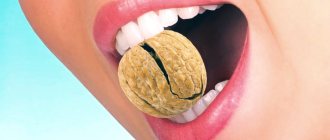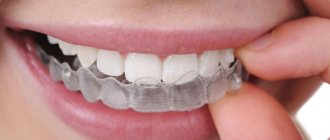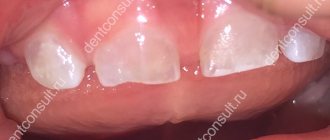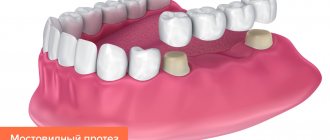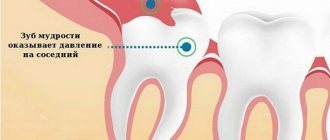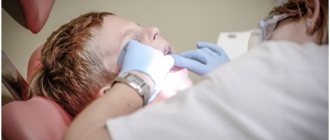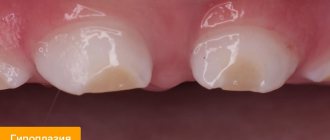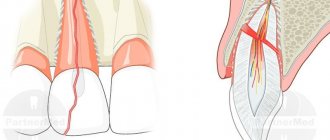Author: Brodsky Sergey Evgenievich Deputy Chief Physician, Candidate of Medical Sciences in the specialties: dentistry and medical microbiology A broken tooth is the cause of discomfort during eating, which can lead to the development of inflammatory processes in the hard and soft tissues of the tooth, root and gum . Therefore, if a defect is detected, you should immediately consult a dentist, who will select the correct method for restoring the tooth.
Causes of tooth fracture
Part of a tooth can chip or break as a result of exposure to internal and external factors. The first group of reasons include:
- pathologies associated with disruption of intrauterine development of surface and hard tissues of the tooth;
- metabolic disorders associated with impaired absorption of calcium, magnesium and phosphorus, provoked by rickets suffered in childhood, the use of diuretics, and poor nutrition;
- diseases of the digestive tract, accompanied by changes in the acidity of saliva, which has a destructive effect on tooth tissue.
A tooth in the gum can break under the influence of a number of external factors, including:
- injuries to the skull and jaw during a fight, road accident;
- tooth injury during dental procedures;
- eating solid foods;
- thermal injury due to the simultaneous consumption of cold and hot food and drinks;
- advanced carious processes;
- incorrect structure of the dentition.
The crown part of the front tooth is broken
If a front tooth is partially fractured, veneers or crowns can be used.
Veneers restore tooth function, protect dentin from external influences, and also the aesthetics of a smile. Treatment is only suitable for slightly damaged teeth. If the dental crown is severely damaged, the dentist will suggest installing a ceramic crown.
Crowns are placed on the remaining part of the tooth after grinding and preparing the surrounding area around the damaged tooth. If a significant part of the tooth has broken off, then to securely fix the crown it will be necessary to make a stump inlay, and in this case the tooth will have to be depulped (remove the nerve and fill the root canal).
The main stages of tooth restoration using a crown:
- Drawing up and agreeing on a treatment plan;
- Next, the doctor grinds the tooth down for a crown;
- Taking a silicone impression. The impression is sent to the dental laboratory. Based on the impression, the technicians reconstruct a plaster model of the teeth, and the technician will model the crown on it;
- When the crown is made, it is tried on and, if there is no discomfort, fixed on the stump.
To close the aesthetic defect, until the permanent crown is made, I install temporary plastic crowns on the patient, which can be made either in the laboratory or in the clinic.
Material for making dental crowns . Front teeth are a person’s calling card. When smiling, in conversation, every person involuntarily exposes his front teeth. Their beauty and health attract their interlocutor. This is why choosing the type of crown for teeth in the smile area is so important. The main types of permanent dental crowns are metal-ceramics, metal-free ceramics and ceramics with a zirconium dioxide frame. The most preferable material, from an aesthetic point of view, for the manufacture of dental crowns for the front teeth is metal-free ceramics e.max or feldspathic ceramics, also ceramics with a zirconium dioxide frame.
What to do if your tooth chipped?
See a dentist.
The doctor will remove the broken wall, take x-rays of the tooth, and evaluate its safety. If the tooth is not broken much, the root is not damaged or almost not damaged, then it can be restored. Then the tooth is prepared (if necessary, dental canals are treated, caries and old filling materials are cleaned), how badly it is damaged is assessed and the best way to restore it is selected (filling, inlay or crown). If the tooth cannot be saved, it is removed and replaced with an implant or other available method.
Restoration method – bridge prosthesis
Dental bridges got their name for their visual resemblance to a bridge - they are a structure of two crowns, between which artificial teeth are located.
Crowns are placed on your own ground teeth. The advantages of bridges are good aesthetics and reliable fixation. Dental bridges are permanent, making them very comfortable. This type of dental prosthetics requires several visits to the doctor. First, impressions are made, from which a temporary prosthesis is made in a denture laboratory or clinic - the patient will not experience discomfort when communicating due to the absence of a front tooth. At the same time, the dental clinic prepares the supporting teeth. They are ground to install a crown to a shape that is optimally suitable for this, and most often (but not always) they are depulped. After the grinding is completed, impressions are taken again, from which dentists make a permanent prosthesis, and after that it is installed on the supporting teeth and fixed with cement.
The main disadvantage of a bridge is the need for depulpation and grinding of healthy supporting teeth. In addition, its installation, which leads to an uneven load on the alveolar bone and its thinning in the area of the missing tooth..
Dentists' recommendations
If a tooth is cracked, you can save it, but you should make an appointment with your dentist right away. The sooner professional help is provided, the less likely there are complications.
Before visiting a doctor, you should adhere to the following recommendations:
- the load on the injured tooth is completely eliminated;
- take only soft or ground food of medium temperature;
- Every hour, rinse your mouth with antiseptic agents, saline solutions or herbal decoctions.
Experts strongly advise against touching a damaged tooth with your fingers or tongue. You should not loosen it or try to use any popular recommendations. When a tooth is cracked, it can only be saved by going to the dentist.
Restoration method - one-stage implantation immediately after root removal
Single-stage implantation of a front tooth involves immediately installing an implant into the socket after tooth extraction. For this type of implantation, special dental implants with aggressive threading and a high degree of primary stabilization are used. On the same day, immediately after implantation, a temporary plastic crown is installed. This implantation allows you to solve two problems - removing a broken tooth root and closing a cosmetic defect. In addition, the method allows you to save a little, because... Some manipulations are not performed (for example, the gum former is not installed).
After 3-4 months, when osseointegration of the implant is complete, permanent crowns are installed. Just as in the case of conventional crowns, from an aesthetic point of view, the best solution for the front teeth is the use of ceramic crowns and, accordingly, abutments. It is preferable to install the crown on a zirconium dioxide abutment, then in any type of lighting the crown will not stand out from the general row of teeth. In our opinion, this option for restoring a broken front tooth is the most optimal.
Light filling on a pin – what are the advantages of the method?
A post filling is considered a reliable replacement material when a dentist is restoring a fractured unit. A titanium or fiberglass pin is inserted into the root canal, after which the coronal part is restored with a composite material. Among the disadvantages of the method is the potential risk of root fracture, since the pin fails under pressure, as well as shrinkage of the filling and the development of secondary caries under it.
Unfortunately, teeth restored in this way do not last forever. After 3–5 years, the dentist will have to change the filling or, due to global destruction of the crown, perform prosthetics/implantation.
Why can a tooth break and why is it dangerous?
The situation when a tooth is cracked, chipped, broken or a piece breaks off is unpleasant and happens unexpectedly. All these cases are called tooth trauma. Acute injury can result from a fall or blow. Chronic - as a result of the habit of eating too hard and viscous foods and such occlusion pathologies that lead to improper distribution of the chewing load. The tooth may be weakened if complications arose after treatment or the treatment was not completed.
The anterior incisors are the most commonly injured teeth. Risk groups include athletes and school-age children. Tooth fractures occur one and a half times more often in men than in women. Malocclusions (open bite, distal bite) significantly increase the likelihood of injury. A small fragment of enamel or a significant portion may break, including a dentin or root fracture.
When a small fragment breaks, it often does not cause pain, but only disturbs the appearance. However, a violation of the integrity leads to the penetration of infection into the tooth cavity and the development of caries, and then pulpitis. A change in the shape of a tooth entails a change in its closure with other units and malocclusion in the future. In the absence of treatment, a fractured tooth is likely to have a curvature of the root and the development of complications in the form of granulomas and cysts.
In cases of acute injury, severe pain, bleeding gums, and tooth mobility are possible. A fracture that exposes the pulp is called complete; without exposing the pulp, it is called incomplete. A doctor can assess the extent of damage and possible consequences by studying the clinical picture and x-ray examination. For each case, the appropriate treatment tactics will be selected.
Causes of dental chips
To choose the right treatment, the dentist needs to determine why the tooth chipped.
What factors cause such damage?
- Domestic injuries;
- Low acidity in the mouth;
- Remineralization of tooth enamel;
- Bite disorders;
- Dental pathologies that have not been treated previously;
- Bad habits;
- Hormonal imbalances.
Chips are considered traumatic if the teeth were damaged during an impact or fall. But in everyday life, dental tissues are much more often destroyed due to bad dental habits (biting nails, office supplies, etc.) and performing actions for which teeth are not intended at all (opening bottles with teeth, tying knots, etc.).
If you combine very hot and cold dishes when eating, this also contributes to the destruction of enamel. An increased content of carbohydrates in the diet helps reduce acidity in the mouth; alcohol and tobacco also negatively affect the condition of teeth.
Dental health largely depends on how rationally you eat. If your food lacks vitamins and microelements, the strength of the enamel decreases and chips may occur more often. Following the principles of a healthy diet and undergoing regular dental checkups will help reduce the likelihood of this.
Also, chipped teeth can occur when there is a hormonal imbalance. This happens if a patient is diagnosed with diabetes mellitus, thyroid dysfunction and other endocrine pathologies. Women need to be especially attentive to the condition of their teeth during pregnancy.
Various malocclusions that are not corrected in time can also cause trauma to dental tissues. This can happen while chewing or while sleeping if you suffer from bruxism (nighttime teeth grinding). The second danger of this disease is the abrasion of enamel due to erratic movements of the jaw at night, which also increases the risk of chipping.
If you have an incorrect bite, the part of the tooth located next to the gums may also be damaged. If a piece of enamel adjacent to your gum has chipped off, this may be caused by caries that has affected the cervical area of the tooth.
In each of the above cases, it is necessary to visit a dentist as soon as possible. He will not only restore the injured tooth, but, having established the cause of the incident, will prescribe additional treatment if necessary.
What types of fractures can there be?
The most common diagnosis is a tooth root injury. In this case, the maxillary row is more often susceptible to this type of fracture, since due to its anatomical location it takes on the entire force of the blow. To establish such a diagnosis, radiography is indispensable. A crack or fracture of dentin is usually detected on the lower jaw.
By direction they distinguish:
- Vertical
- the most serious injury that often occurs during dental treatment. It affects the deep structures of the tooth, including the pulp and gum.
- Transverse (horizontal)
- depending on the level at which the fracture occurred, loosening of the tooth is observed.
- Splintered
- multiple fractures in different places, while the fragments can intersect or shift.
- Oblique
- the fault occurs at an angle.
A tooth fracture in which the pulp chamber is exposed is called complete. Without damage to the pulp - invisible. Often the injury is accompanied by subluxation of the jaw. They are divided into complete and incomplete. With a strong blow, the root of the tooth may become immersed in the socket (impacted dislocation). In this case, surgical intervention is necessary.
Teeth extension using composite materials
Modern filling materials used for the restoration of front teeth harden only under the influence of the rays of a special lamp, most often an ultraviolet one. This gives the specialist the opportunity to carefully restore the natural shape of the damaged tooth. This is especially important when reconstructing large chips. However, after curing, the composite material becomes no less durable than a natural tooth, and if the doctor follows all standards and protocols, the junction of the enamel and the composite will not only be invisible, but also reliable - the tooth restored in this way will last for many years. However, it should be remembered that such restorations still have a service life and after 7 to 10 years they may require replacement.
Types of damage
There are several types of dental injuries with fractures. The classification sign is the depth and degree of injury.
Enamel chip or microcrack
In this case, the integrity of the upper layer of hard tissue is compromised - it cracks, or a small fragment separates. Usually such problems are invisible and do not cause discomfort. These are minor defects that can be quickly treated, but people do not rush to the dentist with them, which is a serious mistake.
What to do if part of a front tooth or a piece of a back tooth chips or falls out? It is important to visit a dental clinic as soon as possible. Damaged structures will become a place for the spread of pathogenic microflora, which will provoke the development of caries and other diseases. In addition, the load when chewing food will increase significantly, so half of the crown may fall off at any moment.
Chip with dentin fracture
Dentists classify this type of damage as moderate. Symptoms may be pronounced or completely absent. If the dentin layer is not restored, the unit will gradually crumble and soon fall apart. In addition, the smile will become unattractive, especially if a piece of an incisor is missing.
Deep fracture to the pulp tissue with exposure of the nerve
This is a severe injury with serious symptoms such as bleeding and severe pain. Even strong painkillers help dull unbearable sensations only for a short time. The crown may be missing half or more. If you are late with medical intervention, the risk of infection, inflammation and other pathological processes that are difficult to treat increases significantly.
